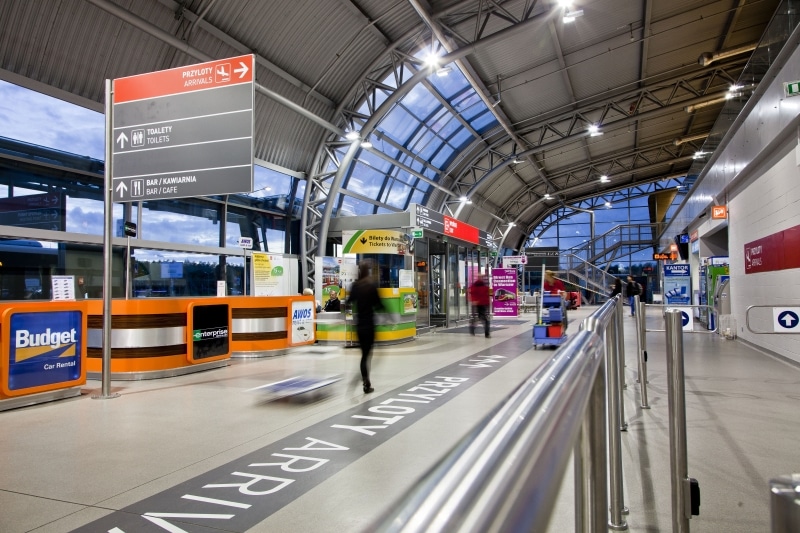“I am not afraid that the establishment of the Central Communication Port (CPK) will threaten the existence of regional airports, including Modlin,” says Tomasz Szymczak, acting president of Mazowiecki Port Lotniczy Warszawa-Modlin. He emphasizes that smaller airports will serve different types of traffic, including low-cost and charter carriers, thus there will be a demand for their development. Especially since the forecasts for regional air traffic are optimistic. The authorities of Modlin airport are planning to expand the port with new gates.
Since the change of government in October 2023, the Central Communication Port (CPK) has been a hot topic in public debate. Recent press reports indicate that the government will proceed with this investment. Government decisions regarding the future of the CPK project between Warsaw and Łódź are expected this month. The impact of the new hub on regional airports frequently arises in this debate. The management of the company operating Warsaw-Modlin airport remains confident about the port’s future, despite it being within CPK’s area of influence.
“The construction of the future central airport for Poland does not exclude the existence of regional airports. Essentially, it may be a more expensive airport than regional ones, which are geared towards different traffic. Therefore, airports not only in Mazovia and central Poland but also more broadly within the influence zone of the future central airport will exist because they will handle different traffic. As we know, many European low-cost carriers do not see their activity at the new central airport but rather prefer dedicated infrastructure for themselves, as is the case across Europe and the world,” Tomasz Szymczak told Newseria Biznes.
In recent years, airports in Gdańsk, Kraków, Katowice, Wrocław, and Poznań have built strong positions and play an important role in the development of their respective regions.
“Not only Mazovia but all of Poland needs this diversification and expansion of regional airports because they are gateways to the regions. Notice that Lufthansa, KLM, and other carriers, not just low-cost ones, fly to regional airports. A large, well-functioning regional airport is always the gateway to a region. The existence of a central hub airport does not exclude this,” says the acting president of Mazowiecki Port Lotniczy Warszawa-Modlin.
Last year was a record year for regional airports. Eleven of the 14 airports associated with the Union of Regional Airports handled nearly 33.2 million passengers in total. This is 12% more than the previous record of 29.7 million in 2019. Compared to 2022, there was a 26% increase. Airports increased traffic in every segment: both point-to-point connections and connections with hub airports in Poland, Europe, America, and Asia. The largest regional airport remains Kraków, handling over 9 million passengers annually, followed by Gdańsk and Katowice with traffic levels of 5.5–5.9 million passengers. The top five also include Wrocław (approx. 3.9 million) and Warsaw-Modlin (3.4 million).
Future forecasts for regional tourism traffic are optimistic. According to the Civil Aviation Authority’s forecast, by 2040, under the base scenario, airports in Poland will handle 96.4 million passengers, with the Warsaw metropolitan area (Chopin Airport, Warsaw-Modlin, Warsaw-Radom) accounting for about 45 million. This means that other regional airports will handle over 50 million passengers combined. Forecasts for Kraków suggest 15.1 million passengers, for Gdańsk 10.8 million, and for Katowice 10.3 million. The Civil Aviation Authority emphasizes that achieving these results by 2040 requires investments in capacity at all airports in Poland. The optimistic outlook, according to Modlin’s president, will not be altered by the decision to build CPK.
“Each central hub airport has its own traffic, serving the national carrier, connecting flights, and long-distance traffic. Regional airports, apart from a few exceptions like Kraków or Rzeszów, which handle American markets albeit much less frequently than the hub airport, cater to different traffic, serving business investments in these regions and tourist traffic,” says Tomasz Szymczak.
Evidence of this is the investment plans of the Mazowiecki Port Lotniczy Warszawa-Modlin company. The airport, located about 35 km northeast of downtown Warsaw, is awaiting expansion. Its authorities speak of the need to enlarge the passenger terminal and increase the number of aircraft parking stands. Building a new runway is also on the list of important future plans. These investments are justified by forecasts indicating that the port may reach its capacity limit in a few years. Modlin also sees a role for itself in cargo transport, primarily carried out at night.
In contrast, Chopin Airport, currently functioning as a hub airport, will be closed once CPK becomes fully operational.
“The closure of existing airports when new greenfield ones are built indeed occurs. This happened in Munich in the 1990s and a few decades later in Oslo, where a new airport further from the city, connected by high-speed rail, led to the closure of the old one,” notes the president of Modlin.
According to current plans, CPK is to become Poland’s main transport hub, serving not only air traffic but also rail and road transport. The investment is planned in central Poland between Warsaw and Łódź, about 40 km from the capital. The concept involves components for both aviation and rail, based on the so-called communication spurs ensuring fast transport to CPK from various regions of the country.
